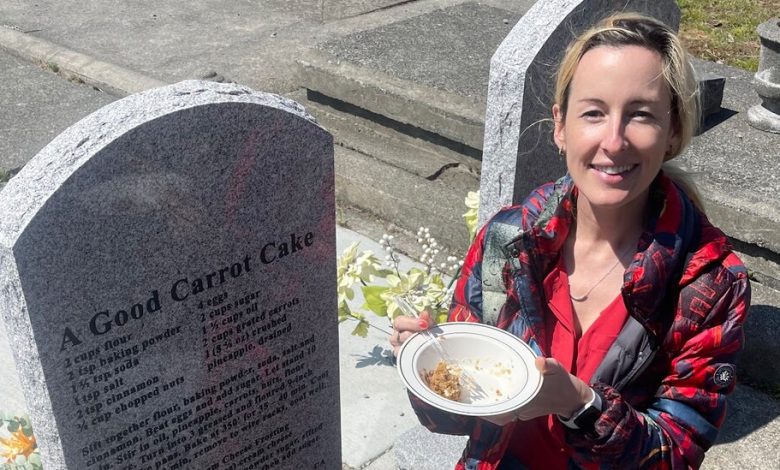Can TikTok Revive the Dead?

When Rosie Grant made ice cream to share with Marian Montfort last month, her biggest challenge was getting it to her.
She had flown from Shreveport, La., to Portland, Maine, where Ms. Montfort was waiting. There she sprinted to her Airbnb, purchased an ice cream maker, gathered and combined the ingredients — dried apricots, apricot preserves, sugar, double cream and a sprinkle of nutmeg — and transported her concoction without its melting through heavy summer rain.
It was tough doing it all alone, but Ms. Montfort couldn’t help her — she had been dead for 16 years. Ms. Grant had followed the recipe inscribed on her headstone.
Ms. Grant is one of many TikTok influencers on the hashtag #gravetok, a space with more than one billion views. Creators post videos of themselves following cooking advice, visiting burial sites and cleaning gravestones. As demand for cremation increases in the United States, they are hoping to inspire a new generation of cemetery enthusiasts, or taphophiles, who can help conserve the country’s past.
Since 2021, Ms. Grant, 33, has been traveling across the country to dine at the burial sites of those who left behind recipes on their tombstones. She finds them through a combination of research and help from her followers and travels to each one armed with a meal she has tenderly prepared.
“On some level it just felt like a really nice gift for these people to leave a recipe behind,” said Ms. Grant, an archivist from Los Angeles who films her graveside meals on her account @ghostlyarchive. “It just felt like the natural progression to go and visit them.”
Among her creations are fudge, snickerdoodles and chicken soup. For Ms. Grant, each of these meals is special, including the ice cream she shared with Ms. Montfort, which she described as “a beautiful moment of calm.”
A deep interest in death rituals is nothing new, said Cole Imperi, a founder of the School of American Thanatology (as in the scientific study of death) and a former board president of the Historic Linden Grove Cemetery and Arboretum in Covington, Ky. Cemeteries are often preserved as both historical sites and gardens that are open to the public, she said.
Ms. Imperi believes the surge of interest in grave tourism is a symptom of modern life. “Social media needs bite-sized pieces of content, and a headstone is a bite-sized story of a person, so those two things are in perfect alignment,” she said. “There’s a sense of rootedness and meaningful heritage from learning about the people that have come before us.”
It’s a quality that other creators have noticed, too.
Caitlin Abrams, 37, a software curriculum developer from rural Vermont with the TikTok account @manicpixiemom, believes her three million followers prefer the stories of the everyday person to those of the famous. In her videos, she restores graves that are centuries old and narrates the clips with details about the deceased person’s life, including family lineage and tragedies of child loss. “We all love to see how other people live,” she said.
It’s hard to say exactly what viewers are looking for on #gravetok. Some describe the community as a pocket-size oasis. “I find walking through cemeteries to be very peaceful,” said Enocha Edenfield, a 42-year-old tour guide and #gravetok follower who lives in Savannah, Ga. “It gives me a chance to think away from the noise of the city while also learning a little about its history through the headstones I pass.”
In the comments under these videos, viewers also share their feelings of satisfaction from watching graves being cleaned or of hope that they might one day be remembered in this way.
The videos sometimes reach the families of the dead people featured in them, said Grace Waronker, a 26-year-old plaster artist from Los Angeles who shares videos through her TikTok account, @grace_goodnight. “When I put up a video of a grave that I’ve come across, a lot of the time the family or friends will see it and say it’s a sign,” she said. “They take it as a signal that that person is OK.”
But creators said there was still work to be done to make #gravetok more inclusive. “Graves only tell us part of the story, because the people who were middle-class and upper-class would have been able to access the stones that still remain,” Ms. Abrams said. “Most of the graves I clean are for white people because mostly white people had access to gravestones.”
Ms. Grant cited America’s history of demolishing Native American burial sites and African American cemeteries as another reason she continues to post about her work — to inspire a new generation of taphophiles who can protect and care for overlooked cemeteries.
“It’s really important for a local community to be connected to their local cemeteries and to care about them on some level,” she said. “It sounds like a weird way to put it, but any amount of support can help to keep the cemetery itself alive.”




